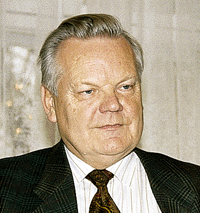|
Prof.
Dr. med. Horst Koeditz
The
Ear as a
Medical Instrument |
|
Lecture
given at the ‘Medical Week Baden-Baden’ |
| |
|
Page
1 2
3 4 |
| |
|
|
|
The
very gifted Kaiser Friedrich II of the House of Hohenstaufen, who was
also very interested in the sciences, wondered in which language children
would begin to express themselves, if they had never ever heard a word
spoken. Would it be Latin, Greek or the oldest language, Hebrew, or
the mother tongue? His lively interest prompted him to carry out an
unusual experiment. He gave attendants and wet-nurses a number of orphaned
new-born children to bring up. They were ordered to give them the breast
and guarantee the best care, but were strictly forbidden to speak a
word, either to them or in their presence. |
|

Prof.
Dr. med. H. Koeditz
was,
until his retirement in 1997, head of the Department of Paediatrics
at the University of Magdeburg and of the University Children’s
Hospital.
From 1990 – 1993, he was Rector of the University of Magdeburg. |
|
| |
|
|
|
But no answer
to the Kaiser’s burning question was to be found, for all of the
children died at a very early age. ‘They could not live without
the praise, the gestures, the friendly facial expressions and caresses
of their attendants and wet-nurses; this is why the songs sung by women
whilst rocking the cradle are called ‘Ammenzauber’ –
lullabies which lull or enchant the child’. That was the verdict
of the chronicler – Salimbene of Parma – in 1240, a remarkable
formulation for that day and age. |
|
|
|
“Via the ear and
its neural connections
to the brain,
music has an immediate
physiological effect
on our entire organism.”
|
|
In Herodotus’s
second book, Psammetic relates a similar story with a less tragic outcome.
Even if these reports are perhaps exaggerated, they are still early
indicators as to how necessary stimulation of the senses is for the
normal development of a child.
Do we not
have the reverse problem today?
Tones and
sounds – natural phenomena, acoustic happenings – threats
to civilisation or balsam for body and soul? |
|
|
|
|
Is music
not a special case of man’s self-made noise – does it thus
belong to environmental noise? Today more than ever since the banishment
of silence, music stands in the conflict of an ecstatic drugged state,
balanced harmony and acoustic pollution. Without exception, people of
all ages come into contact with it, but how do they handle it? Compensation
of worlds of feeling and bodily reactions, mental state and physical
load-bearing capacity.
How sensitive
are our hearing and our stimulus conduction system? How much more constant
bombardment with sound can they endure? What cerebral functions are
activated, which networks can be registered, and how can they be evaluated?
How ill can noise occurrences make you?
However,
this year’s Medical Week Baden-Baden will not be concerned with
this, but with the question of how it is possible to achieve the reverse
effect, namely to make it possible to produce a healing effect on people
via the senses. |
|
|
|
|
|
|






